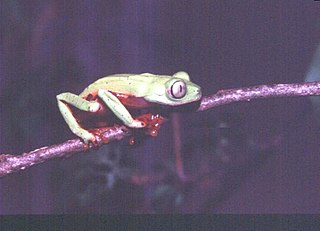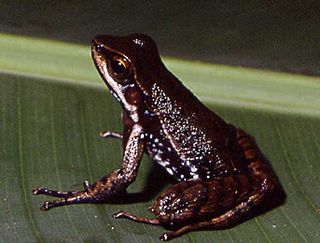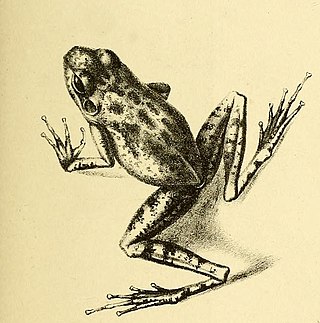
Phasmahyla cochranae, sometimes called the chocolatefoot leaf frog, is a species of frog in the subfamily Phyllomedusinae. It is endemic to Brazil. People have seen it between 800 and 1600 meters above sea level.
Phasmahyla jandaia is a species of frog in the subfamily Phyllomedusinae. It is endemic to Brazil, where it has only been observed more than 1000 meters above sea level.
Phrynomedusa bokermanni, Bokermann's leaf frog, is a species of frog in the subfamily Phyllomedusinae. It is endemic to Brazil.

Bahius is a genus of frog in the family Strabomantidae. It contains a single species, Bahius bilineatus, commonly called the Two-lined robber frog.
Hylodes amnicola is a species of frog in the family Hylodidae. It is endemic to Minas Gerais in Brazil. It has been observed 1400 meters above sea level.

Hylodes is a genus of frogs in the family Hylodidae. The genus may be paraphyletic with respect to Megaelosia. The genus Hylodes is endemic to southeastern Brazil. Member species are also known commonly as the tree toads, or more ambiguously, as torrent frogs. They are diurnal and usually inhabit shallow mountain streams.

Hylodes asper, the warty tree toad or Brazilian torrent frog, is a species of frogs in the family Hylodidae. It is endemic to the Rio de Janeiro and São Paulo states in southeastern Brazil. Living in a high-noise environment, the species uses "semaphoring" to supplement acoustic signalling.
Hylodes babax or the Caparao Mountains tree toad is a species of frog in the family Hylodidae. It is endemic to Brazil.
Hylodes charadranaetes, or the Rio tree toad, is a species of frog in the family Hylodidae. It is endemic to Brazil. Its natural habitats are subtropical or tropical moist lowland forest, subtropical or tropical moist montane forest, and rivers. It is threatened by habitat loss.
Hylodes glaber or the Itatiaia tree toad is a species of frog in the family Hylodidae. It is endemic to Brazil and has been observed in and near Itatiaia. Its natural habitats are subtropical or tropical moist montane forest, subtropical or tropical high-altitude grassland, and rivers. It is threatened by habitat loss.

Hylodes heyeri is a species of frog in the family Hylodidae. It is endemic to Brazil. Its natural habitats are subtropical or tropical moist lowland forest, subtropical or tropical moist montane forest, rivers, and subterranean habitats on the Atlantic side of the country. It is threatened by habitat loss.
Hylodes lateristrigatus is a species of frog in the family Hylodidae. It is endemic to Brazil. Its natural habitats are subtropical or tropical moist lowland forest, subtropical or tropical moist montane forest, and rivers. It is threatened by habitat loss.
Hylodes magalhaesi, or the São Paulo tree toad, is a species of frog in the family Hylodidae. It is endemic to Brazil. Its natural habitats are subtropical or tropical moist montane forest and rivers. It is threatened by habitat loss. They measure between 28 and 32 mm, and live at altitudes of 1400 to 1800 m in the Mantiqueira mountain range.

Hylodes nasus is a species of frog in the family Hylodidae. It is endemic to Brazil. Its natural habitats are subtropical or tropical moist lowland forest and rivers. This frog has been observed 1400 meters above sea level.
Hylodes ornatus or the ornate tree toad is a species of frog in the family Hylodidae. It is endemic to Brazil. Scientists know it from the type locality, Parque Nacional do Itatiaia in the state of Rio de Janeiro. Its natural habitats are subtropical or tropical moist lowland forest, subtropical or tropical moist montane forest, and rivers. It is threatened by habitat loss.
Hylodes otavioi, Otavio's stream frog, or the Otavio tree toad is a species of frog in the family Hylodidae.
Hylodes perplicatus or Humboldt's tree toad is a species of frog in the family Hylodidae. It is endemic to Brazil. Its natural habitats are subtropical or tropical moist lowland forest and rivers. It is threatened by habitat loss.

Hylodes phyllodes, or the Boraceia tree toad, is a species of frog in the family Hylodidae. It is endemic to Brazil. It has been observed in Serro do Mar in the state of São Paulo. Its natural habitats are subtropical or tropical moist lowland forest and rivers. It is threatened by habitat loss.

Hylodes sazimai is a species of frog in the family Hylodidae. It is endemic to Brazil. Its natural habitats are subtropical or tropical moist lowland forest, subtropical or tropical moist montane forest, and rivers. It is threatened by habitat loss.
Hylodes vanzolinii is a species of frog in the family Hylodidae.








